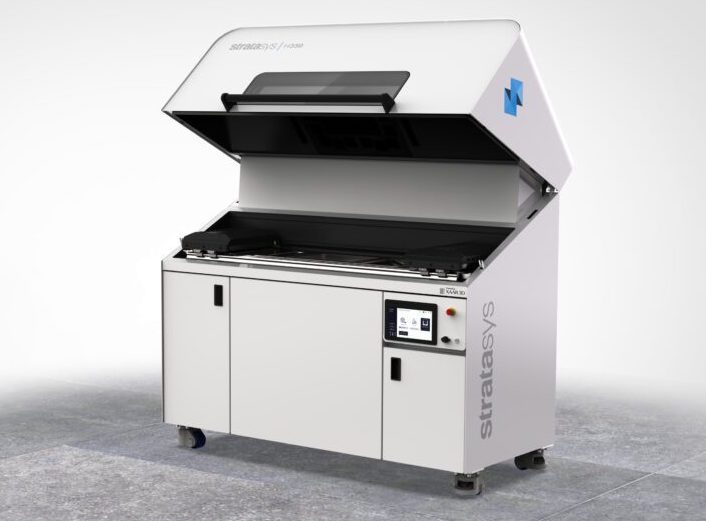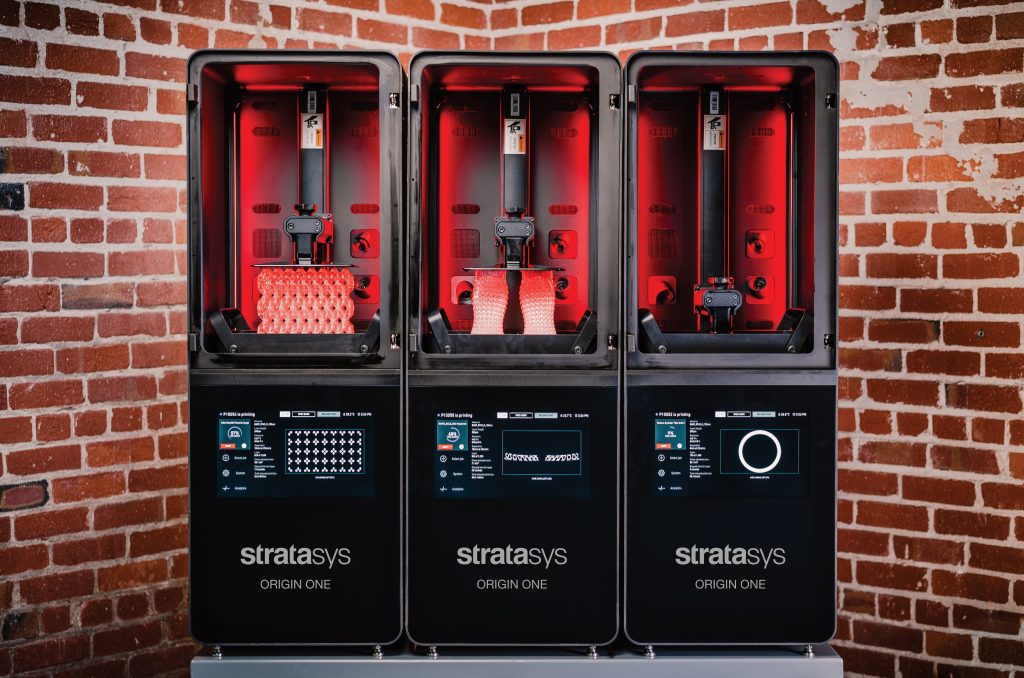Shares in the industrial 3D printer manufacturer Stratasys have risen 14% after the firm announced that it returned to pre-pandemic revenue levels during the third quarter of 2021.
As revealed in its latest financials, the company generated $159 million of revenue in Q3 2021, which is 24% more than the $128 million it brought in over Q3 2020, and flat against the $157 million reported in Q3 2019. This rapid recovery was driven by a 30% rise in the firm’s Products sales, which grew in tandem with a rapid expansion of its 3D printer offering, from $84 million in Q3 2020 to $109 million in Q3 2021.
Stratasys’ results have been well-received by investors, who sent its shares soaring after their publication. According to its CEO Yoav Zeif, the company’s acquisition-driven approach to broadening its portfolio, has also brought it to an “inflection point” at which it’s now able to offer clients bespoke alternatives, to replace many of the traditional manufacturing technologies they may still be using.
“Additive manufacturing is now viable for production in a wide range of end-use parts at a volume-scale for global distribution,” Zeif told analysts on the firm’s earnings call. “Just over a year ago, I laid out our strategy to become the first choice for polymer 3D printing with a focus on our biggest addressable market: manufacturing. This quarter we truly accelerated execution of that strategy.”
“The investments we are making at Stratasys along with the strategic initiatives we have undertaken, are steadily driving revenue growth.”

Stratasys’ Q3 2021 results
During Q3 2021, Stratasys reported significant revenue growth across both its two main segments: Products and Services, with the former generating the majority of its takings. At $109 million, the division’s sales were $3 million higher than they were in the pre-COVID Q3 2019, which the firm’s CFO Lilach Payorski told analysts, was down to rising demand for the F370, F770, F900 and new Dentajet 3D printers.
In one particularly lucrative Q3 deal, the company was contracted by the U.S. Navy to supply up to 25 F900 machines for creating end-use parts, tooling and training aids, netting it $20 million in revenue. Stratasys’ strong machine uptake also prompted its consumable income to rise 27% between Q3 2020 and 2021, and due to increased utilization, its ancillary Product sales only fell 1% short of 2019 levels.
The firm’s Service income also grew 14% from the $44 million generated in Q3 2020, to $50 million in Q3 2021, meaning that it just fell short of the $51 million reported during Q3 2019. Even so, Payorksi told the call’s participants that its Stratasys Direct manufacturing bureau “delivered more than was expected,” thanks to the “strong demand from medical” seen for anatomical models created by its J750 3D printers.
| Stratasys Revenue ($) | Q3 2020 | Q3 2021 | Difference (%) | Q3 2019 | Q3 2021 | Difference (%) |
| Products | 84m | 109m | +30 | 106m | 109m | +3 |
| Services | 44m | 50m | +14 | 51m | 50m | -2 |
| Total Revenue | 128m | 159m | +24 | 157m | 159m | +1 |
Expansion-led growth in Q3
Following on from a Q2 in which it exceeded its own revenue guidance, Stratasys’ results in Q3 represent its fourth straight quarter of annual growth. Much like its Q2 performance, the strong demand seen for its machines was largely driven by the wider array of 3D printers it now offers, with those it has developed in-house set to be supplemented by systems it has inherited via acquisitions imminently.
Earlier this year, Stratasys launched its new J5 MediJet 3D printer, a system capable of producing highly-accurate surgical guides and medical tooling, which no doubt boosted its income from healthcare users. In fact, Zeif told analysts on the earnings call that medical was now the firm’s “fastest-growing market,” with the likes of Ricoh 3D leveraging its tech to create point of care hospital models across the U.S.
Likewise, having launched its new J35 Pro and the J55 Prime 3D printers in June 2021, the company’s prototyping and research clientele will have driven its Q3 sales growth too, while its acquisition of Origin and takeover of Xaar3D, will see it add further new machines to its lineup in the near future, but they aren’t expected to bring in significant sales until 2022.

Based on the Selective Absorption Fusion (SAF) technology it has steadily developed alongside its Xaar 3D subsidiary, the firm’s H350 3D printer is already said to be making waves during beta testing. According to Zeif, the feedback from early adopters, many of which are service bureaus, “has been outstanding” and the machine is not only “producing end-use parts” but doing so “at a volume-scale.”
To complement its slew of new machines, Stratasys has also bolstered its software offering recently, with AMFG joining its Partner Program, and the release of its new ProtectAM data security platform. While the latter is specifically designed to cater for defense users, Zeif says that the company’s broader-than-ever software portfolio can help drive its ongoing machine sales growth in the quarters to come.
“[In future], we anticipate that software will be an increasing part of our revenues and profit streams,” Zeif said on Stratasys’ earnings call. “Driven by recurring software licence subscriptions and SDK licences from partners and customers, it’s a key part of our overall rapid growth plan for our manufacturing business as well.”

Stratasys “still in investment mode”
In their closing remarks on Stratasys’ earnings call, Payorski and Zeif provided a cautious outlook on its continued growth prospects heading into Q4. Given that the firm is “carefully monitoring ongoing logistical and inflationary pricing” issues, Payorksi said it’s increasing production levels to ensure that customer supplies aren’t affected, meaning that its Q4 margins will be similar to those seen in Q3.
The company’s growth outlook for Q4 2021 is similarly conservative at 16%, while its operating expenses are due to rise to $36 million, due to the ongoing costs of running its acquired subsidiaries. Despite this, Payorski added that Stratasys has around $520 million in cash and equivalents, thus it is “still in investment mode,” and “constantly reviews opportunities that will accelerate its growth strategy.”
Adding to Payorski’s remarks, Zeif concluded that the firm’s acquisition-led approach has now granted it a solid platform for growth, which “provides customers with solutions for every step in the product life cycle,” and positions it well to achieve its stated goal of becoming the outright leader of the polymer additive manufacturing market.
“There is no single, comprehensive solution for every manufacturing application,” concluded Zeif. “Therefore, it is important to use the best technology for each specific manufacturing challenge. Only Stratasys provides the full range of best in class technologies for polymer 3D printing, offering our customers the ability to choose the best fit for their applications.”
“Our exceptional portfolio of hardware, materials, software platforms and partnerships together with industry-leading global experts sets us apart.”
To stay up to date with the latest 3D printing news, don’t forget to subscribe to the 3D Printing Industry newsletter or follow us on Twitter or liking our page on Facebook.
For a deeper dive into additive manufacturing, you can now subscribe to our Youtube channel, featuring discussion, debriefs, and shots of 3D printing in-action.
Are you looking for a job in the additive manufacturing industry? Visit 3D Printing Jobs for a selection of roles in the industry.
Featured image shows an engineer using Stratasys’ F900 3D printer. Photo via Stratasys.


